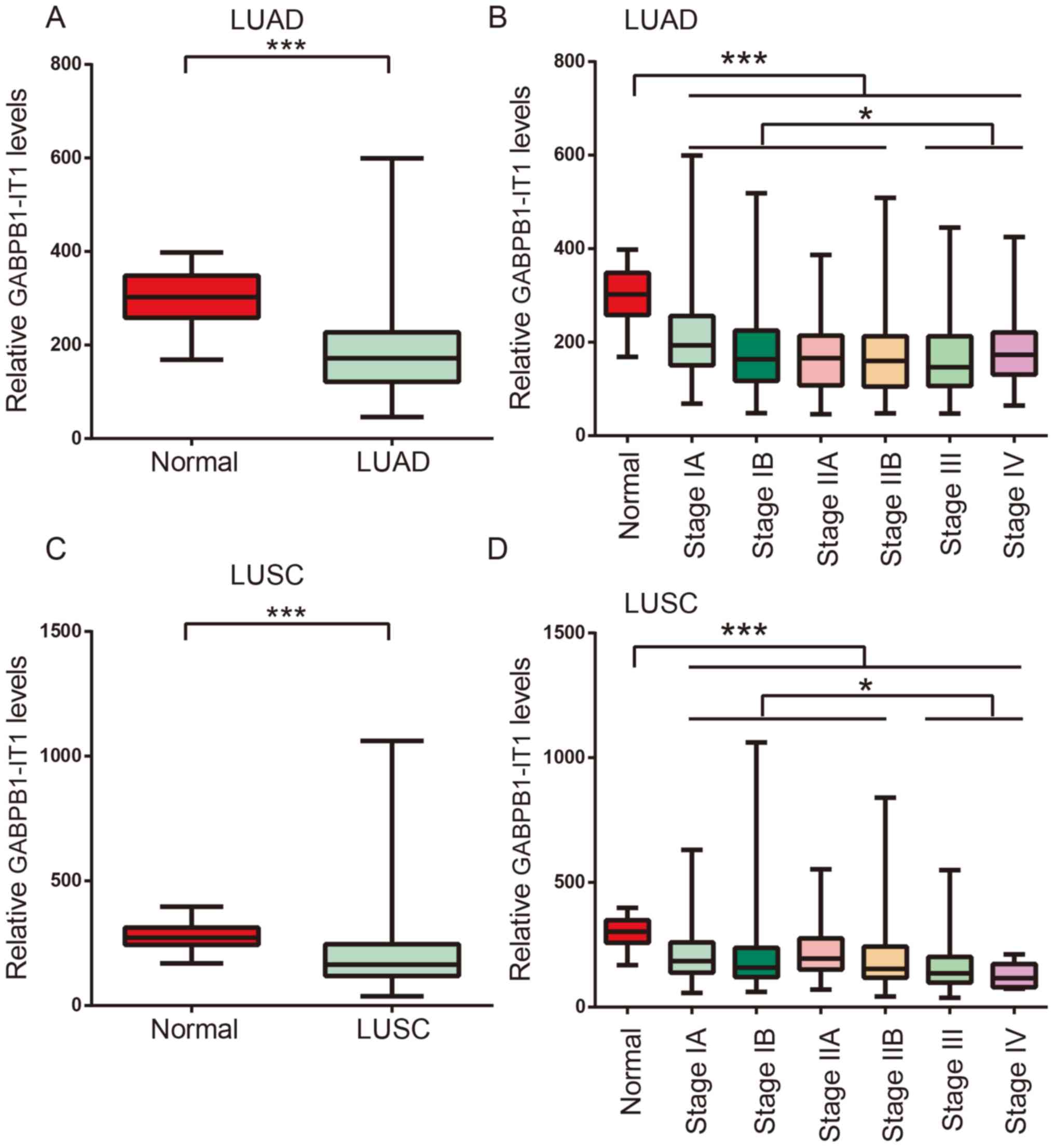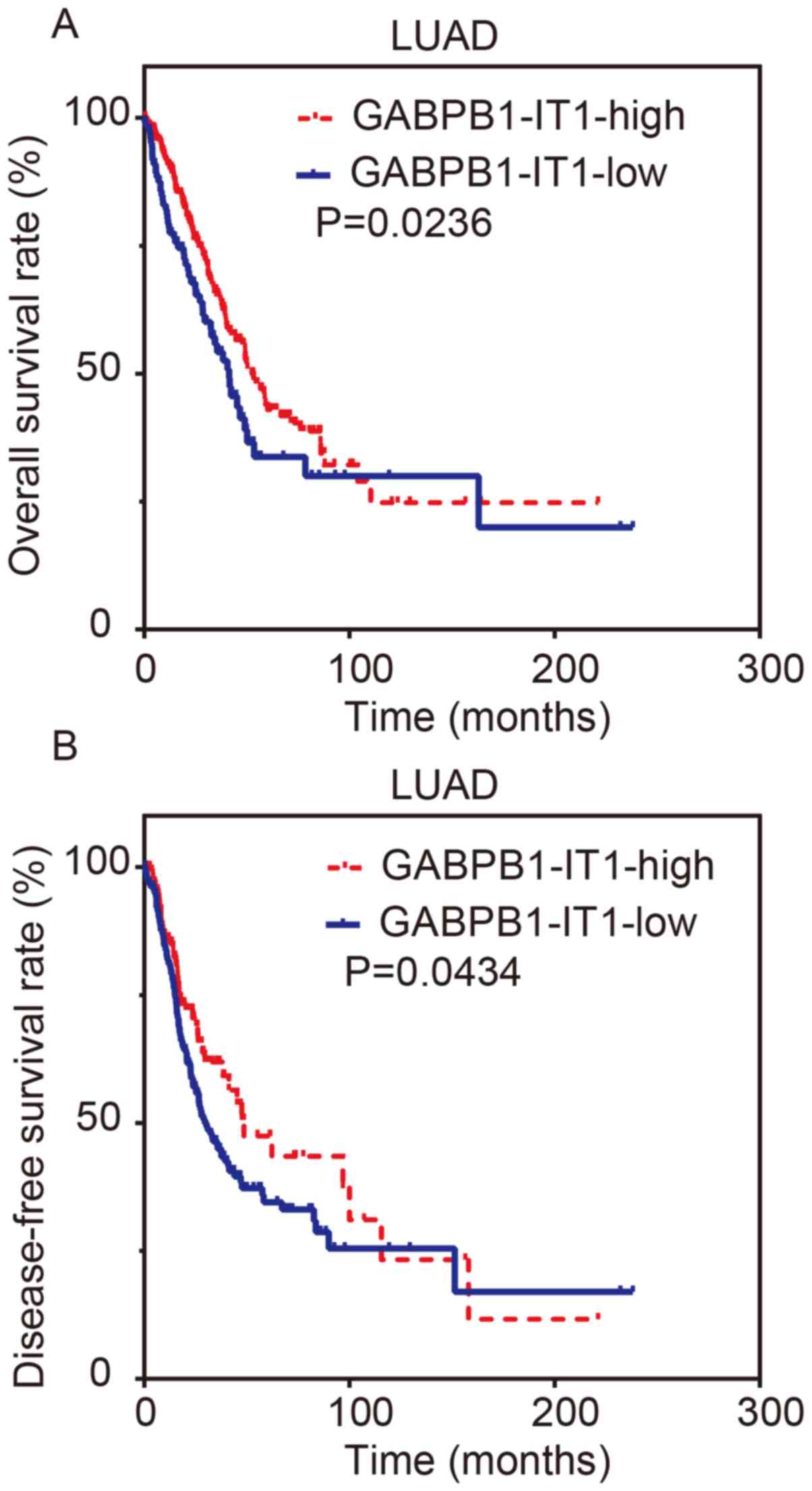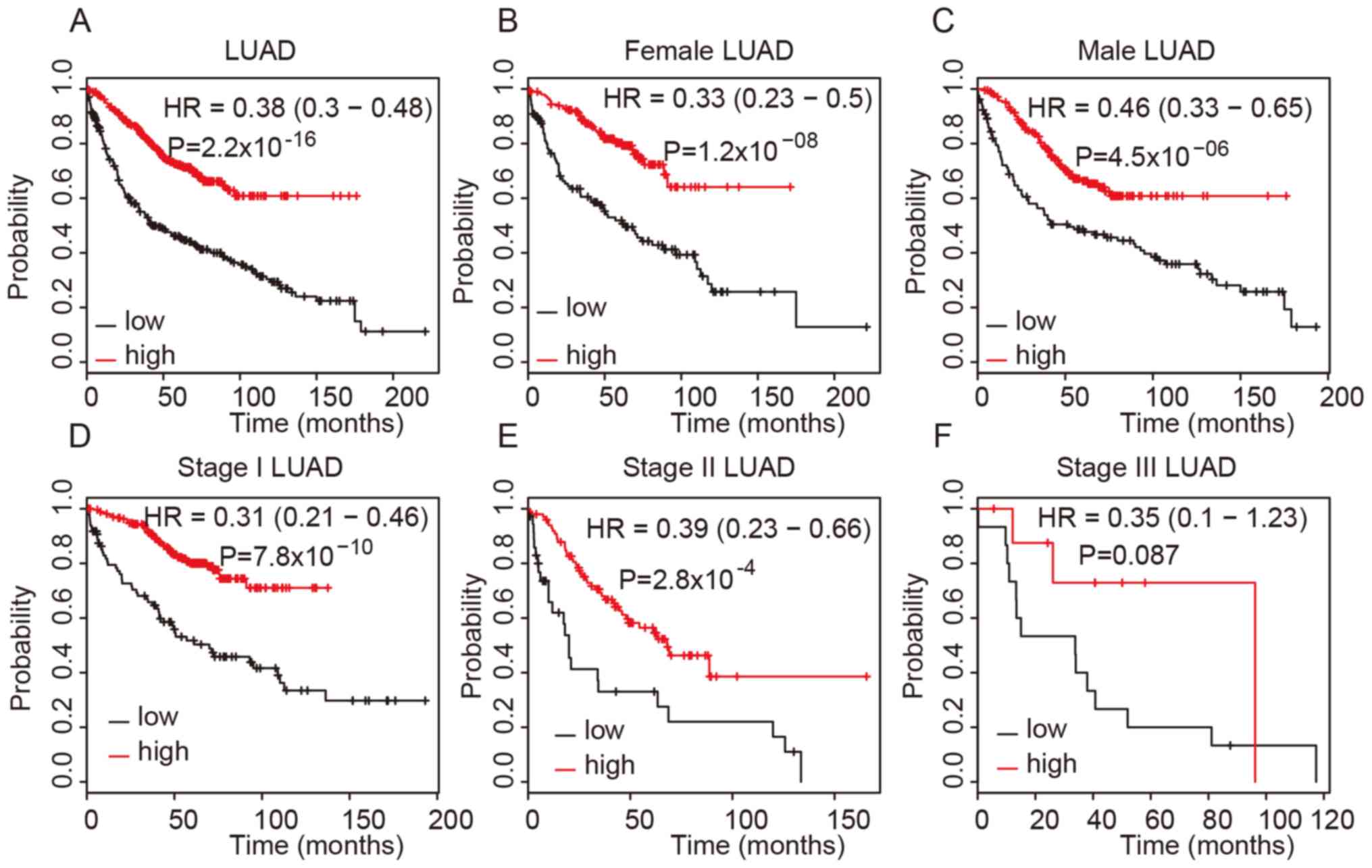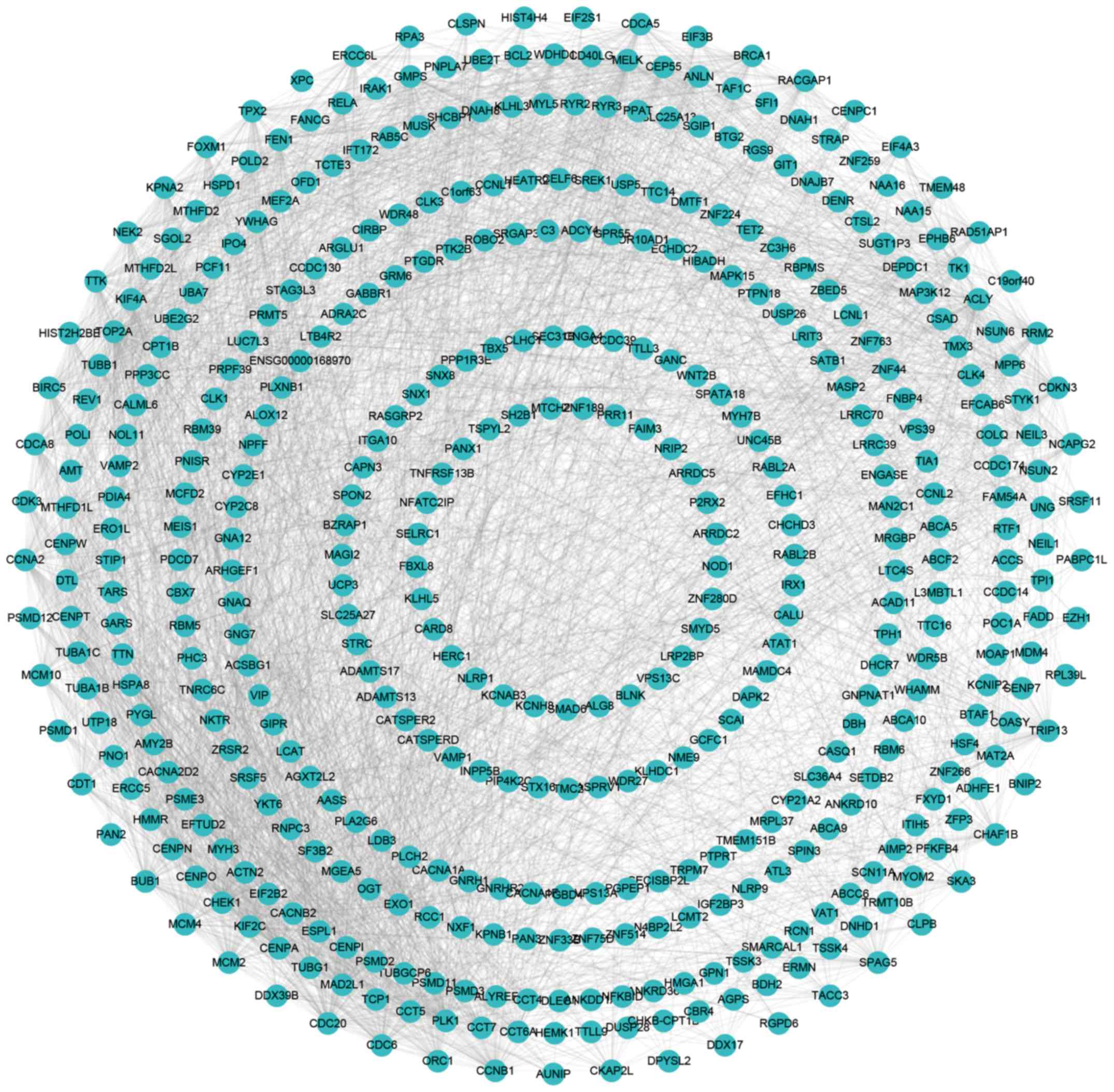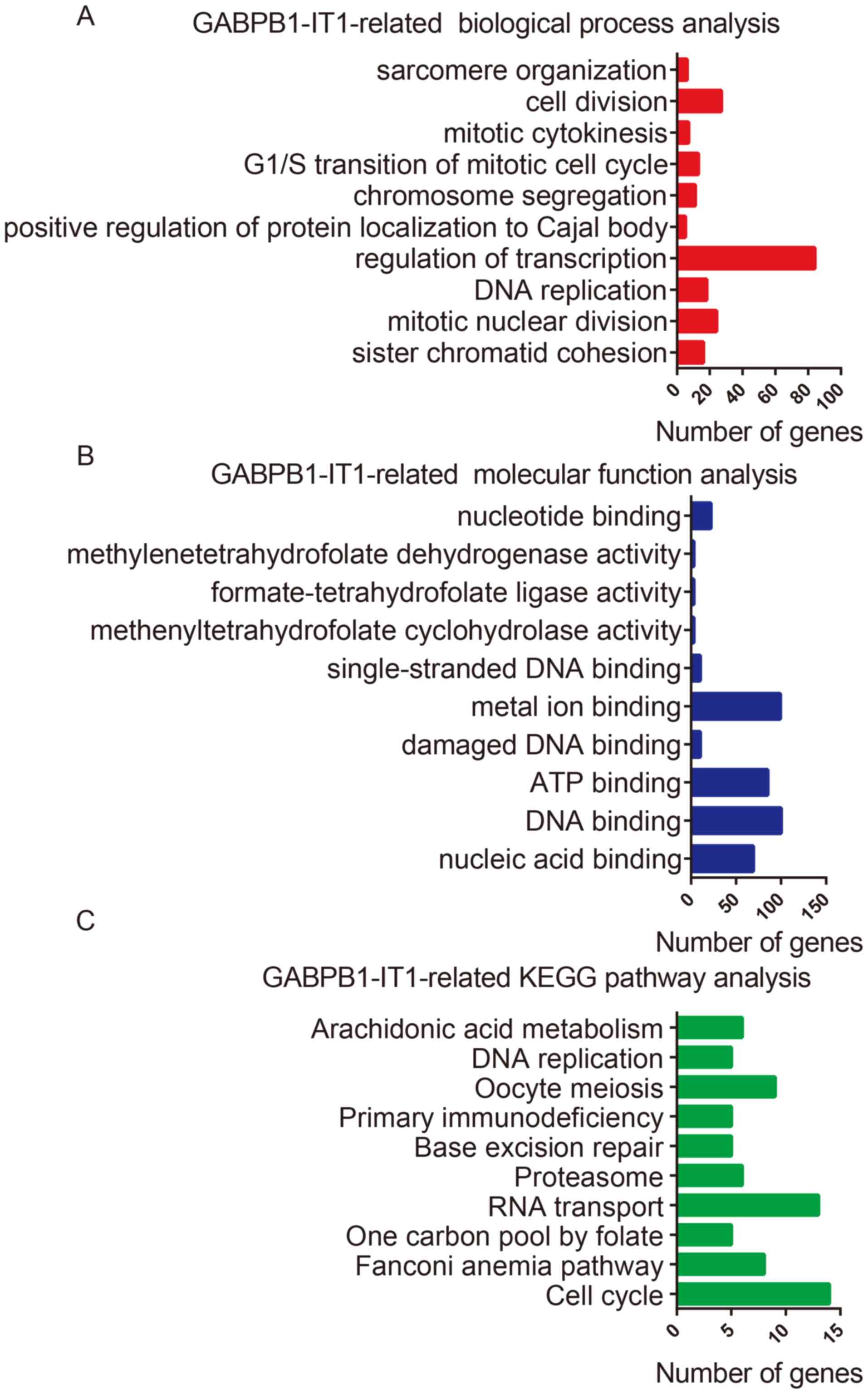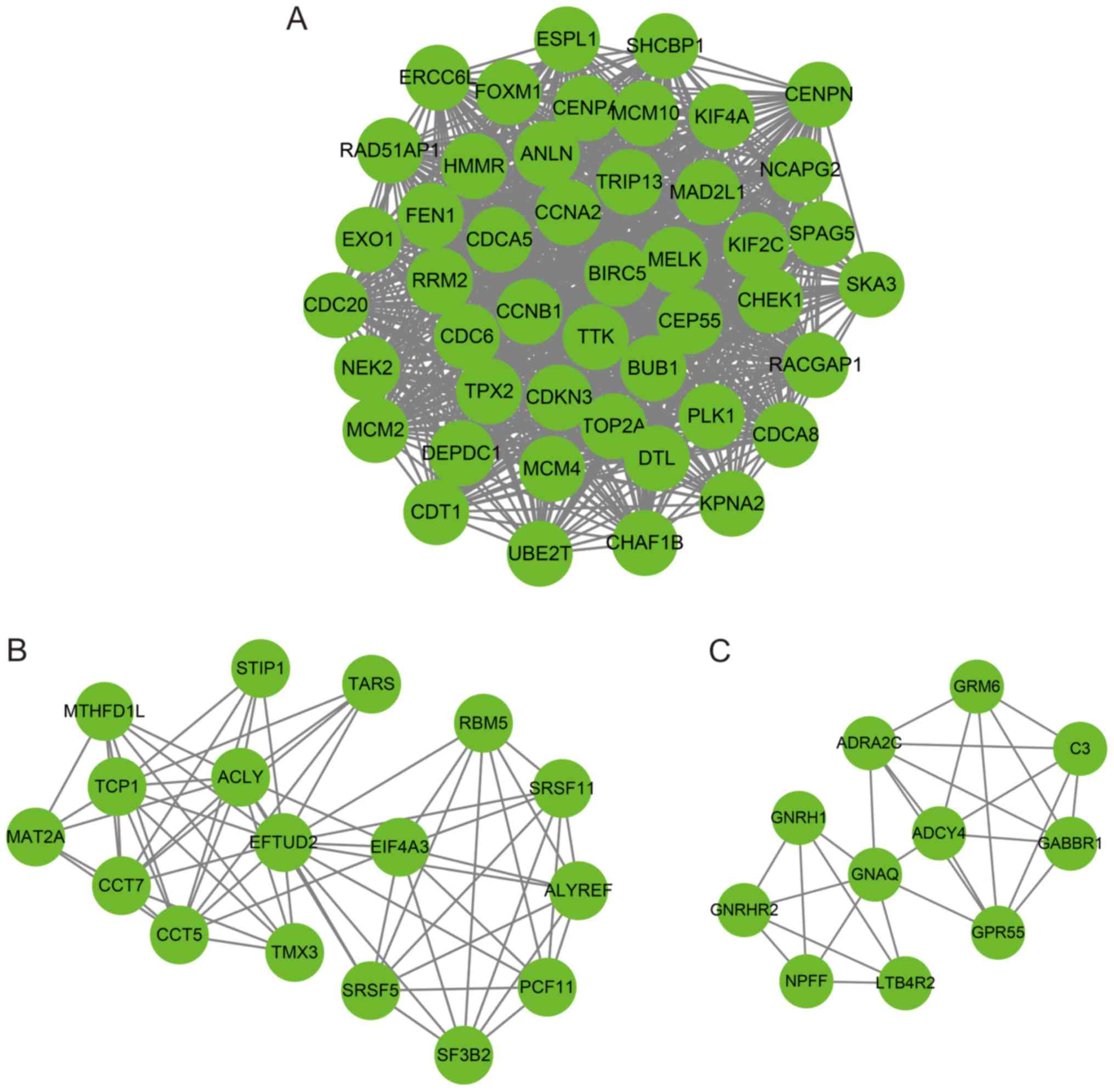Introduction
Long non-coding RNAs (lncRNAs) are a class of
non-coding RNAs, which consist of >200 nucleotides that are not
translated into proteins (1,2). Previous studies have revealed that
lncRNAs serve important roles in various types of human disease by
regulating gene transcription, epigenetic modifications and cell
proliferation (3,4). In previous studies, an abnormal
expression of lncRNAs has been observed in different types of
cancer, including lung, liver, gastric, prostate and breast cancer
(5,6). Notably, lncRNAs have been demonstrated
to possess significant potential prognostic value for cancer. For
example, it has been reported that the sensitivity of the lncRNA
prostate cancer antigen 3 is higher compared with prostate-specific
antigen for the urinary detection of prostate cancer (7). Decreased expression of the lncRNA
SLC7A11-AS1 predicted a poor prognosis in gastric cancer (8). Higher LINC00959 expression has been
negatively associated with Tumor-Node-Metastasis (TNM) stage,
distant metastasis and lymphatic metastasis, and negatively
correlated with improved prognosis in colorectal cancer (9). Therefore, investigation of
cancer-associated lncRNAs could provide novel insights that assist
with the identification of biomarkers for cancer.
Lung cancer, including small cell lung carcinoma and
non-small cell lung carcinoma (NSCLC), is the leading cause of
cancer-associated mortality worldwide in 2018 (10). In the USA, lung cancer was estimated
to account for 26% of all cancer-associated mortalities in 2017
(11). In China, ~730,000 new cases
of lung cancer were diagnosed in 2015 and 610,000 lung-cancer
associated mortalities were reported (12). In the USA, despite improvements in
lung cancer treatment, the 5-year survival rate for lung cancer
remains as low as ~15% in 2018 (13). NSCLC is the predominant type of lung
cancer and accounts for 80% of lung cancer cases (14). A number of lncRNAs have been
identified to be associated with NSCLC progression. For example,
the lncRNA small nucleolar RNA host gene 1 promotes NSCLC
progression via an upregulation of metadherin by sponging microRNA
(miR)-145-5p (15). The lncRNA
X-inactive specific transcript has been reported to promote the
transforming growth factor-β-induced epithelial-mesenchymal
transition by regulating the miR-367/141-zinc finger E-box binding
homeobox 2 axis in NSCLC (16). In
addition, Lai et al (17)
identified that the lncRNA myocardial infarction associated
transcript promotes NSCLC proliferation and metastasis via matrix
metallopeptidase 9 activation. However, to the best of our
knowledge, the molecular function and prognostic value of the
majority of lncRNAs in NSCLC remain unknown.
The present study investigated the expression of the
lncRNA GABPB1 intronic transcript (GABPB1-IT1) in NSCLC tissues
using publicly available databases. Subsequently, the associations
between GABPB1-IT1 expression and the characteristics of patients
with NSCLC were evaluated. Protein-protein interaction (PPI) and
co-expression networks were constructed to identify key targets of
GABPB1-IT1. Furthermore, gene ontology (GO) and Kyoto Encyclopedia
of Genes and Genomes (KEGG) pathway analyses were performed to
investigate the potential roles of GABPB1-IT1. The present study
provides useful information that may assist with the investigation
of potential candidate biomarkers for diagnosis, prognosis and drug
targets for NSCLC.
Materials and methods
Microarray data and data
preprocessing
The gene expression data of lung adenocarcinoma
(LUAD) and lung squamous cell carcinoma (LUSC) were downloaded from
The Cancer Genome Atlas (TCGA; http://cancergenome.nih.gov/) database. TCGA data was
downloaded from cBioPortal (http://cbioportal.org). The methods of biospecimen
procurement, RNA isolation and RNA sequencing were performed as
previously described by the Cancer Genome Atlas Research Network
(18). Patient clinical features,
including age at diagnosis, overall survival time, disease-free
survival time, pathological tumor (T) stage and node (N) stage,
were retrospectively obtained from patient records. All the
patients were staged using the 2009 TNM classification of the
American Joint Committee on Cancer/International Union Against
Cancer (19).
Survival analysis
Kaplan-Meier plotter (KM plotter) is a web tool that
predicts the effect of genes on survival (kmplot.com/analysis/index.php?p=service&cancer=lung
version: 2016.04.08) (20). By
entering the gene of interest into the website, patients were
divided into two groups according to the expression level of the
gene and the survival rate was statistically analyzed. The hazard
ratio with 95% confidence intervals and the log-rank P-value were
calculated and presented for each analysis.
Co-expression network construction and
analysis
The Pearson correlation coefficient of
GABPB1-IT1-mRNA pairs was calculated according to the expression
value. The co-expressed GABPB1-IT1-mRNA pairs with a Pearson
correlation coefficient ≥0.30 were selected to generate a
co-expression network using Cytoscape software (version 3.4.0;
www.cytoscape.org/). According to this cut-off
value, ~5% (896/18,603) of the mRNAs were included in this
co-expression network. The Cytoscape MCODE plug-in was used for
visualization of the co-expression networks.
Construction of a PPI network and
module analysis
To predict protein interactions, including physical
and functional associations, the present study used the Search Tool
for the Retrieval of Interacting Genes (STRING) database (21) to construct a PPI network of
GABPB1-IT1 co-expressing mRNAs. The associations of the proteins
encoded by the DEGs were analyzed using STRING and a combined score
>0.4 was used as the cut-off criterion. In addition, Cytoscape
software 3.4.0 (http://cytoscape.org/download_old_versions.html) was
used for visualization of the PPI networks (22). Following the construction of the PPI
network, a module analysis of the network was performed using the
Cytoscape MCODE plug-in with the following criterion: Degree
cut-off ≥2 (23). Additionally,
Network Analyzer (a plug-in for Cytoscape) was used to compute the
basic properties of the PPI network, including the average
clustering coefficient distribution, closeness centrality, average
neighborhood connectivity, node degree distribution, shortest path
length distribution and topological coefficients (24).
GO & KEGG pathway analysis
To identify functions of the DEGs in NSCLC, GO
functional enrichment analysis was performed for the following
three categories: Biological process, cellular component and
molecular function. In addition, KEGG pathway enrichment analysis
was performed to identify pathways enriched in NSCLC using the
database for annotation, visualization and integrated discovery
(DAVID) (https://david.ncifcrf.gov/).
P<0.05 was considered to indicate a statistically significant
result.
Statistical analysis
All statistical analyses were performed using R
software version 3.3 (Detail in http://www.r-project.org) and GraphPad Prism 6
software (GraphPad Software, Inc. La Jolla, CA, USA). All numerical
data are presented as the mean ± standard deviation of a minimum of
three determinations. Statistical comparisons between two groups of
normalized data were performed using a Mann-Whitney U test.
Differences among multiple groups were analyzed by one-way analysis
of variance (ANOVA) following Bonferroni post hoc test. P<0.05
was considered to indicate a statistically significant
difference.
Results
lncRNA GABPB1-IT1 is downregulated in
NSCLC
The expression levels of GABPB1-IT1 in NSCLC were
analyzed using TCGA data from cBioPortal (www.cbioportal.org/). As presented in Fig. 1A, analysis of the TCGA LUAD dataset
revealed that the expression level of GABPB1-IT1 was significantly
lower in tumor tissues compared with normal tissues. To further
validate this result, the TCGA LUSC dataset was analyzed, which
also revealed a significantly lower expression level of GABPB1-IT1
in tumor samples compared with normal tissues (Fig. 1C).
To further evaluate the possible prognostic value of
GABPB1-IT1, LUAD and LUSC RNA-seq data from TCGA were analyzed. It
was identified that GABPB1-IT1 expression was significantly lower
in patients with stage I (P<0.001), II (P<0.001), III
(P<0.001) and IV (P<0.001) NSCLC compared with the normal
controls (Fig. 1B and D).
Furthermore, it was revealed that the expression level of
GABPB1-IT1 was significantly lower in high grade NSCLC samples
(stages III and IV) compared with low grade NSCLC samples (stages I
and II; Fig. 1B and D).
Downregulation of GABPB1-IT1 predicts
a poor prognosis in NSCLC
Kaplan-Meier analysis was performed to determine
whether GABPB1-IT1 expression was significantly associated with
disease-free survival and overall survival time in patients with
NSCLC by analyzing TCGA LUAD dataset. The median GABPB1-IT1
expression level in NSCLC tissues was used as the cut-off value to
divide all cases into high and low GABPB1-IT1 groups. The results
revealed that the overall survival and disease-free survival rates
were significantly higher in the GABPB1-IT1-high group compared
with the GABPB1-IT1-low group (Fig. 2A
and B). These results indicate that GABPB1-IT1 expression could
serve as a biomarker to predict the outcome of NSCLC.
Subsequently, the Kaplan-Meier plotter database was
used to comprehensively analyze the association of lncRNA
GABPB1-IT1 expression with the survival rates in various types of
LUAD. As presented in Fig. 3, the
overall survival time was lower in the GABPB1-IT1-low groups
compared with the GABPB1-IT1-high groups for all LUAD cases, female
LUAD cases and male LUAD cases (Fig.
3A-C) and for stages I, II and III LUAD cases (Fig. 3D-F).
Co-expression network analysis and
enrichment analysis of GABPB1-IT1 in NSCLC
The present study performed co-expression network
analysis to predict the potential role of GABPB1-IT1 in NSCLC by
calculating the Pearson correlation coefficient of
GABPB1-IT1-target pairs. A Pearson correlation coefficient ≥0.30
was selected as the cut-off value to identify potential GABPB1-IT1
targets in NSCLC. The co-expression network, constructed using
Cytoscape, is presented in Fig. 4.
In total, the network included 896 mRNAs.
DAVID was used to perform GO and pathway analysis of
the co-expressing genes of GABPB1-IT1. GO analysis revealed that
GABPB1-IT1 was predominantly involved in ‘sister chromatid
cohesion’, ‘mitotic nuclear division’, ‘DNA replication’,
‘regulation of transcription’, ‘positive regulation of protein
localization to Cajal body’, ‘chromosome segregation’, ‘G1/S
transition of mitotic cell cycle’, ‘mitotic cytokinesis’, ‘cell
division’ and ‘sarcomere organization’ (Fig. 5A). Furthermore, the molecular
functions of GABPB1-IT1 were associated with ‘nucleic acid
binding’, ‘DNA binding’, ‘ATP binding’, ‘damaged DNA binding’ and
‘metal ion binding’ (Fig. 5B).
KEGG pathway analysis revealed that GABPB1-IT1 was
primarily enriched in pathways associated with ‘Cell cycle’,
‘Fanconi anemia pathway’, ‘One carbon pool by folate’, ‘RNA
transport’, ‘Proteasome’, ‘Base excision repair’, ‘Primary
immunodeficiency’, ‘Oocyte meiosis’, ‘DNA replication’ and
‘Arachidonic acid metabolism’ (Fig.
5C).
Construction of a
GABPB1-IT1-associcated PPI network
Based on the STRING database, a PPI network was
constructed to predict the interaction associations among 896
GABPB1-IT1 co-expressed proteins in NSCLC (combined score >0.4).
Following the construction of the PPI network, a module analysis of
the network was performed using the MCODE plugin (degree cut-off
≥2).
Three hub-networks associated with lncRNA GABPB1-IT1
were identified. As presented in Fig.
6, one hub-network contained 46 nodes, including DEPDC1, CCNA2,
SKA3, TPX2, HMMR, FOXM1, NCAPG2, CENPN, CDKN3, MCM10, ESPL1,
RAD51AP1, MAD2L1, SHCBP1, CHEK1, EXO1, CDT1 and FEN1, and 964 edges
(Fig. 6A). Another hub-network
contained 17 nodes, including SRSF5, ACLY, ALYREF, TARS, SRSF11,
TCP1, CCT5, EIF4A3, MTHFD1L, SF3B2, EFTUD2, RBM5, PCF11, CCT7,
MAT2A, TMX3 and STIP1, and 67 edges (Fig. 6B). The final hub-network contained 11
nodes, including C3, GNAQ, GPR55, GRM6, GABBR1, ADRA2C, GNRH1,
LTB4R2, GNRHR2, ADCY4 and NPFF, and 28 edges (Fig. 6C).
Discussion
Lung cancer is the leading cause of
cancer-associated mortality worldwide and the 5-year survival rate
for lung cancer is as low as ~15% (13). In China, ~730,000 new cases of lung
cancer were diagnosed in 2015 and >610,000 lung
cancer-associated mortalities were reported (12). Previous studies have demonstrated
that lncRNAs are associated with lung cancer prognosis and a number
of lncRNAs have been reported to be dysregulated in lung cancer.
For example, Luo et al (25)
identified that the lncRNAs RP5-821D11.7, APCDD1L-AS1 and
RP11-277P12.9 were associated with the prognosis of lung squamous
cell carcinoma. Overexpression of lncRNA MetaLnc9 in human NSCLC
samples has been correlated with a poor prognosis, and has been
revealed to promote migration and invasion of NSCLC cells in
vitro, and enhance lung metastasis formation in vivo
(26). The present study
demonstrated that GABPB1-IT1 expression was significantly
downregulated in LUSC and LUAD samples compared with normal samples
by analyzing TCGA datasets. Furthermore, it was identified that
GABPB1-IT1 expression was lower in high grade NSCLC samples
compared with low grade NSCLC samples. Using Kaplan-Meier analysis,
the present study revealed that higher expression levels of
GABPB1-IT1 in NSCLC were associated with an improved survival time
in different types and stages of LUAD, including female, male,
stage I, stage II and stage III LUAD samples. To the best of our
knowledge, the current study is the first to report that GABPB1-IT1
may serve as a biomarker for NSCLC.
Previous studies have revealed that lncRNAs serve
important roles in various types of human disease by regulating
expression of protein-coding genes through transcriptional,
post-transcriptional and posttranslational regulation. For example,
the lncRNA small nucleolar RNA host gene 20 has been demonstrated
to promote NSCLC cell proliferation and migration by epigenetically
silencing p21 expression (27). The
lncRNA long intergenic non-protein coding RNA 673 has been
identified to promote NSCLC metastasis by binding with enhancer of
zeste 2 polycomb 2 and causing epigenetic silencing of homeoboz A5
(28). The present study revealed
that GABPB1-IT1 may serve as a biomarker for NSCLC; however, the
functional roles of GABPB1-IT1 remain largely unknown. The current
study performed co-expression analysis for GABPB1-IT1 and then used
DAVID to perform GO and pathway analysis for the co-expressed
genes. GO analysis revealed that GABPB1-IT1 was predominantly
involved in cell cycle and proliferation by regulating a number of
cell cycle-associated biological processes, including ‘sister
chromatid cohesion’, ‘mitotic nuclear division’, ‘DNA replication’,
‘regulation of transcription’, ‘chromosome segregation’, ‘G1/S
transition of mitotic cell cycle’, ‘mitotic cytokinesis and cell
division’. Molecular functions showed GABPB1-IT1 was mainly
involved in regulating DNA binding, suggested that GABPB1-IT1 may
participate in the regulation of targets transcription. KEGG
pathway analysis identified that GABPB1-IT1 was primarily enriched
in pathways associated with ‘Cell cycle’, ‘Fanconi anemia pathway’,
‘One carbon pool by folate’, ‘RNA transport’, ‘Proteasome’, ‘Base
excision repair’ and ‘Primary immunodeficiency’. Furthermore, a
GABPB1-IT1-associated PPI network was constructed for NSCLC. Taken
together, the results of the present study indicate that GABPB1-IT1
co-expressing genes were involved in regulating cell proliferation,
such as MCM10 and CCNA2.
In conclusion, to the best of our knowledge, the
present study is the first to report that GABPB1-IT1 is associated
with the prognosis of NSCLC. Low GABPB1-IT1 expression levels were
observed in NSCLC samples and were revealed to be associated with
poor survival of patients with NSCLC. Furthermore, potential roles
for GABPB1-IT1 in the regulation of the cell cycle were identified
and a GABPB1-IT1-associated PPI network was constructed for NSCLC.
In summary, the present study may assist with the identification of
new therapeutic and prognostic targets for NSCLC.
Acknowledgements
Not applicable.
Funding
No funding was received.
Availability of data and materials
All data generated or analyzed in this study are
included in this manuscript.
Authors' contributions
JX and MC conceived and designed the study, and
wrote, reviewed and revised the manuscript. JX, GX and QC obtained
the data. JX, ZX and WB analyzed and interpreted the data. All
authors read and approved the manuscript.
Ethics approval and consent to
participate
Not applicable.
Patient consent for publication
Not applicable.
Competing interests
The authors declare that they have no competing
interests.
References
|
1
|
Zamore PD and Haley B: Ribo-gnome: The big
world of small RNAs. Science. 309:1519–1524. 2005. View Article : Google Scholar : PubMed/NCBI
|
|
2
|
Kornienko AE, Guenzl PM, Barlow DP and
Pauler FM: Gene regulation by the act of long non-coding RNA
transcription. BMC Biol. 11:592013. View Article : Google Scholar : PubMed/NCBI
|
|
3
|
Wan X, Huang W, Yang S, Zhang Y, Pu H, Fu
F, Huang Y, Wu H, Li T and Li Y: Identification of
androgen-responsive lncRNAs as diagnostic and prognostic markers
for prostate cancer. Oncotarget. 7:60503–60518. 2016. View Article : Google Scholar : PubMed/NCBI
|
|
4
|
Shi X, Sun M, Liu H, Yao Y and Song Y:
Long non-coding RNAs: A new frontier in the study of human
diseases. Cancer Lett. 339:159–166. 2013. View Article : Google Scholar : PubMed/NCBI
|
|
5
|
Zhang H, Chen Z, Wang X, Huang Z, He Z and
Chen Y: Long non-coding RNA: A new player in cancer. J Hematol
Oncol. 6:372013. View Article : Google Scholar : PubMed/NCBI
|
|
6
|
Hauptman N and Glavač D: Long non-coding
RNA in cancer. Int J Mol Sci. 14:4655–4669. 2013. View Article : Google Scholar : PubMed/NCBI
|
|
7
|
Ferreira LB, Palumbo A, de Mello KD,
Sternberg C, Caetano MS, de Oliveira FL, Neves AF, Nasciutti LE,
Goulart LR and Gimba ERP: PCA3 noncoding RNA is involved in the
control of prostate-cancer cell survival and modulates androgen
receptor signaling. BMC Cancer. 12:5072012. View Article : Google Scholar : PubMed/NCBI
|
|
8
|
Luo Y, Wang C, Yong P, Ye P, Liu Z, Fu Z,
Lu F, Xiang W, Tan W and Xiao J: Decreased expression of the long
non-coding RNA SLC7A11-AS1 predicts poor prognosis and promotes
tumor growth in gastric cancer. Oncotarget. 8:112530–112549. 2017.
View Article : Google Scholar : PubMed/NCBI
|
|
9
|
Sun ZQ, Chen C, Zhou QB, Liu JB, Yang SX,
Li Z, Ou CL, Sun XT, Wang GX, Song JM, et al: Long non-coding RNA
LINC00959 predicts colorectal cancer patient prognosis and inhibits
tumor progression. Oncotarget. 8:97052–97060. 2017. View Article : Google Scholar : PubMed/NCBI
|
|
10
|
Sun S, Schiller JH and Gazdar AF: Lung
cancer in Never-Smokers: A different disease. Nat Rev Cancer.
7:778–790. 2007. View
Article : Google Scholar : PubMed/NCBI
|
|
11
|
Stewart B and Wild CP: World cancer
report. 2014:Health. 2017.
|
|
12
|
Chen W, Zheng R, Baade PD, Zhang S, Zeng
H, Bray F, Jemal A, Yu XQ and He J: Cancer statistics in China,
2015. CA Cancer J Clin. 66:115–132. 2016. View Article : Google Scholar : PubMed/NCBI
|
|
13
|
Herbst RS, Morgensztern D and Boshoff C:
The biology and management of non-small cell lung cancer. Nature.
553:446–454. 2018. View Article : Google Scholar : PubMed/NCBI
|
|
14
|
Brennan P, Hainaut P and Boffetta P:
Genetics of lung-cancer susceptibility. Lancet Oncol. 12:399–408.
2011. View Article : Google Scholar : PubMed/NCBI
|
|
15
|
Lu Q, Shan S, Li Y, Zhu D, Jin W and Ren
T: Long noncoding RNA SNHG1 promotes non-small cell lung cancer
progression by up-regulating MTDH via sponging miR-145-5p. FASEB J.
32:3957–3967. 2018. View Article : Google Scholar : PubMed/NCBI
|
|
16
|
Li C, Wan L, Liu Z, Xu G, Wang S, Su Z,
Zhang Y, Zhang C, Liu X and Lei Z: Long non-coding RNA XIST
promotes TGF-β-induced epithelial-mesenchymal transition by
regulating miR-367/141-ZEB2 axis in non-small-cell lung cancer.
Cancer Lett. 418:185–195. 2018. View Article : Google Scholar : PubMed/NCBI
|
|
17
|
Lai IL, Yang CA, Lin PC, Chan WL, Lee YT,
Yen JC, Chang YS and Chang JG: Long noncoding RNA MIAT promotes
non-small cell lung cancer proliferation and metastasis through
MMP9 activation. Oncotarget. 8:98148–98162. 2017. View Article : Google Scholar : PubMed/NCBI
|
|
18
|
Cancer Genome Atlas Research Network, ;
Kandoth C, Schultz N, Cherniack AD, Akbani R, Liu Y, Shen H,
Robertson AG, Pashtan I, Shen R, et al: Integrated genomic
characterization of endometrial carcinoma. Nature. 497:67–73. 2013.
View Article : Google Scholar : PubMed/NCBI
|
|
19
|
Rami-Porta R, Ball D, Crowley J, Giroux
DJ, Jett J, Travis WD, Tsuboi M, Vallieres E, Goldstraw P,
Committee IS, et al: The IASLC lung cancer staging project:
Proposals for the revision of the T descriptors in the forthcoming
(seventh) edition of the TNM classification for lung cancer. J
Thoracic Oncol. 2:593–602. 2007. View Article : Google Scholar
|
|
20
|
Győrffy B, Surowiak P, Budczies J and
Lánczky A: Online survival analysis software to assess the
prognostic value of biomarkers using transcriptomic data in
non-small-cell lung cancer. PLoS One. 8:e822412013. View Article : Google Scholar : PubMed/NCBI
|
|
21
|
Szklarczyk D, Franceschini A, Kuhn M,
Simonovic M, Roth A, Minguez P, Doerks T, Stark M, Muller J, Bork
P, et al: The STRING database in 2011: Functional interaction
networks of proteins, globally integrated and scored. Nucleic Acids
Res. 39:D561–D568. 2011. View Article : Google Scholar : PubMed/NCBI
|
|
22
|
Shannon P, Markiel A, Ozier O, Baliga NS,
Wang JT, Ramage D, Amin N, Schwikowski B and Ideker T: Cytoscape: A
software environment for integrated models of biomolecular
interaction networks. Genome Res. 13:2498–2504. 2003. View Article : Google Scholar : PubMed/NCBI
|
|
23
|
Bader GD and Hogue CW: An automated method
for finding molecular complexes in large protein interaction
networks. BMC Bioinformatics. 4:22003. View Article : Google Scholar : PubMed/NCBI
|
|
24
|
Assenov Y, Ramirez F, Schelhorn SE,
Lengauer T and Albrecht M: Computing topological parameters of
biological networks. Bioinformatics. 24:282–284. 2008. View Article : Google Scholar : PubMed/NCBI
|
|
25
|
Luo Y, Xuan Z, Zhu X, Zhan P and Wang Z:
Long non-coding RNAs RP5-821D11. 7, APCDD1L-AS1 and RP11-277P12. 9
were associated with the prognosis of lung squamous cell carcinoma.
Mol Med Rep. 17:7238–7248. 2018.PubMed/NCBI
|
|
26
|
Yu T, Zhao Y, Hu Z, Li J, Chu D, Zhang J,
Li Z, Chen B, Zhang X, Pan H, et al: MetaLnc9 facilitates lung
cancer metastasis via a PGK1-activated AKT/mTOR pathway. Cancer
Res. 77:5782–5794. 2017. View Article : Google Scholar : PubMed/NCBI
|
|
27
|
Liu J, Liu L, Wan JX and Song Y: Long
noncoding RNA SNHG20 promotes gastric cancer progression by
inhibiting p21 expression and regulating the GSK-3β/β-catenin
signaling pathway. Oncotarget. 8:80700–80708. 2017.PubMed/NCBI
|
|
28
|
Ma C, Wu G, Zhu Q, Liu H, Yao Y, Yuan D,
Liu Y, Lv T and Song Y: Long intergenic noncoding RNA 00673
promotes non-small-cell lung cancer metastasis by binding with EZH2
and causing epigenetic silencing of HOXA5. Oncotarget.
8:326962017.PubMed/NCBI
|















